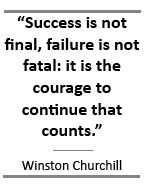
I recently learned of an exhibit making its way through the US, on loan from a Swedish museum. The exhibit, “
The Museum of Failure,” is partially funded by the Swedish Innovation Authority and provides a learning experience around failure and the importance of risk taking in products and service innovation. This unique exhibit caused me to reflect on failure in general, the types of failure, and how to respond to it.
While never pursued as an outcome, failure is inevitable in business and in life. The consequences can be negative and may require immediate, corrective action; however, it often leads to new insights that only become evident because of failure. To this end, failure is a positive catalyst for learning and growth. In corporate cultures where innovation is valued, failure is embraced and even expected as a requisite condition for creation.
Although there are many ways to analyze failure in a professional setting, and there is much thought leadership written on the subject, my simplification of the matter is to categorize it as either avoidable or unavoidable.
Failure that is avoidable occurs when it could have been foreseen or anticipated but was not. In this regard, it may be the worse of the two buckets because it suggests that with proper planning, the pain associated with it might have been avoided. This occurs frequently when established or reasonably known process or practice is followed, which can be tricky because sometimes the failure is the result of positive intent. For example, a sincere willingness to help can lead to over-commitment and failure. While the intent is in the right place, the result remains that there is a lack of progress or forward movement. Further, this category of failure can be difficult to celebrate or even embrace, regardless of intent, because it leads to unnecessary pain.

Failure that is unavoidable, on the other hand, occurs when circumstances could not have been anticipated, or at least reasonably so. It may be easier to accept this type failure, both at the organizational and personal levels, as there are often elements outside of the control of the existing environment. It is also easier to move beyond it more quickly. However, moving too quickly could cause a secondary failure and a missed opportunity to identify change that may mitigate future failures.
While encouraging appropriate risk taking and accepting the inevitable failure is an important element of developing experience and wisdom, it is also important to recognize the failure and subsequent change that occurs. There is an element of risk in diminishing the value of this by focusing on making the person feel that the failure itself is being rewarded. A society of trophies for everyone, including the last place team, can create an environment where the emphasis is misplaced.
Responding to failure, regardless how it is categorized, is important and doing so with objectivity and intent leads to a positive part of overall development. While my personal experiences around failure are certainly no end all, here are a few things I do when I experience meaningful failure in business and in life:
- Conduct an objective and blameless analysis of why it happened. I frequently ask for perspectives from others involved to ensure I have the best perspective of the situation. In doing so, I give them permission to be completely honest and not to worry about delivery of what might be uncomfortable messages. While I remind myself that I am not a failure as a person, I do accept the fact that I did not put forth my best effort and therefore need to learn something from the experience.
- Determine if there were signs that something was not going right. Where my failure was avoidable, I go back to the process or procedure step-by-step and replay the development of the project to assess if there were missed opportunities to identify and anticipate problems.
- Identify changes that will prevent the failure from happening again. Sometimes, the way to avoid failure is to maintain open lines of communications. With the speed of play and continually changing priorities, managing expectations through open dialogue can shift what might otherwise be a failing effort to one that is viewed favorably. The lack of communication could become a separate failure.
- Commit to making a change and share with someone else. Sharing what will be changed is also a great way to reinforce the change itself. Where change is needed, I find that I need help from someone else who can help to hold me accountable.
The disruptions surrounding our clients and profession demand change at the organizational and individual level. This change will require innovation on both a macro and micro level. As such, an ability to understand, accept, and embrace failure will be important. Firms that are committed to thriving, moving forward and becoming future ready will ensure that failure is not something to fear, rather a necessary byproduct of a culture of innovation.
